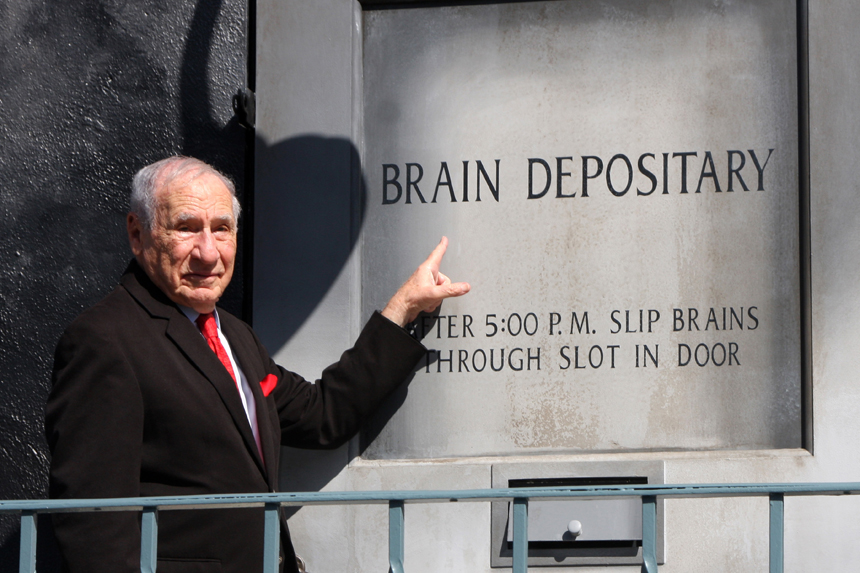It’s been called both wildly funny and wildly offensive. The Library of Congress selected it for preservation in the National Film Registry and had to change its original name to avoid being confused for pornography. It’s one of the funniest movies ever made and . . . no, that’s it. It’s one of the funniest movies ever made. It’s Blazing Saddles, and it just turned 50.
1. A Comedy Committee
Blazing Saddles original trailer (Uploaded to YouTube by Rotten Tomatoes Classic Trailers)
The genesis for Blazing Saddles came from an outline by author and screenwriter Andrew Bergman called Tex-X. The bones of the story were there (town hires Black sheriff) and Bergman even made a deal to make the film, but that eventually crumbled. Enter Mel Brooks. He loved the idea and paid Bergman for the rights so he could direct. However, instead of sending Bergman on his way, Brooks assembled a writer’s room with himself, Bergman, Alan Uger (later known as an Emmy-winning writer for Family Ties), Norman Steinberg (My Favorite Year and more), and Richard Pryor to turn the original idea into a new screenplay. All five writers are credited on the final film, though the last drafts were done by Brooks and Bergman. Somewhat hilariously, all five are also credited on the 2022 animated film Paws of Fury: The Legend of Hank, because its story about a wannabe dog samurai in a land of cats was expressely conceived as a homage to Saddles; in fact, in early drafts, it was called Blazing Samurai. Mel Brooks even voiced one of the characters!
2. Creating the Cast
“People of the Land . . .” (Uploaded to YouTube by phantasm 57)
Pryor almost played Sherriff Bart, but Warner Bros. thought that his drug woes at the time presented insurance risks. As such, Cleavon Little got the job. A number of names were floated for Jim, aka “The Waco Kid,” including John Wayne; Wayne declined because the script was too raunchy for his image, but he was still supportive of the project. Gig Young was actually hired and began shooting; on his first day, he took ill from the effects of alcohol withdrawal. Gene Wilder stepped in. Other major roles were filled out by comedy stars like Harvey Korman (Hedley Lamarr) and Madeline Kahn (Lili Von Shtüpp). Western vet Slim Pickens played henchman Taggart, and future college and pro football hall of famer Alex Karras would memorably play Mongo. Brooks himself would have three on-camera roles (including Governor Petomane) and two voiceover parts.
3. Not Getting the Joke
Mongo punches the horse (Uploaded to YouTube by Munden)
Aside from the work it took to find the right cast, Brooks had to wrangle several challenges from the studio. People questioned everything from the fart jokes to the frequent use of slurs. Even the classic scene where Mongo punches a horse was in danger from executives. Brooks chose to ignore it all and forge ahead. Before the movie was even finished, screen legend (and genius inventor) Hedy Lamarr sued because she caught wind of the villain’s name. Her suit alleged that the gag name of Hedley Lamarr was an invasion of her privacy. Brooks chose to pay a settlement to keep the gag because of his admiration for Lamarr; since the film was still in production at the time, he added a line about the lawsuit itself, turning the legal situation into meta-humor.
4. Critical Reaction
The Campfire scene (Uploaded to YouTube by Movieclips)
While a few critics were harsh on the film for reasons running from vulgarity to using old jokes, the larger number of reviewers found more to celebrate. Years before they teamed up on PBS, both Roger Ebert and Gene Siskel weighed in with positive takes; Ebert said the movie “does everything to keep us laughing except hit us over the head with a rubber chicken,” while Siskel was confident that the film was “bound to rank with the funniest of the year.” The film also drew three Academy Award nominations (for Best Song for the eponymous theme, Best Editing, and Best Supporting Actress for Kahn). But of course, the best reaction came from the viewing public, who voted with their feet and their dollars. Audiences made Blazing Saddles the second-highest moneymaker of the year behind The Towering Inferno (and less than $5 million behind at that).
5. Lasting Legacy
Blazing Saddles is universally considered one of the funniest films ever made. Part of the reason is its fearlessness. It skewers everything from race relations to movie conventions. You get moments that approach profundity, like Waco Kid’s brief monologue on morons, side by side with Mongo’s infamous horse punch. The conclusion of the film entirely throws any pretense out the window and crashes into the movie studio and modern Burbank beyond. Brooks didn’t just make a broad satire; he made a satire broad enough to hit everything. Perhaps the most impressive trick that Brooks pulled stems from the fact that Blazing Saddles was only the first film he released in 1974. He also put out Young Frankenstein, which, crazily enough, is also considered one of the funniest films ever made and earned more than any other movie released that year except for two: Inferno … and Blazing Saddles. With that kind of success and lasting impact, Brooks got the last laugh.
But it’s fair to say that Blazing Saddles won’t be delivering its final laugh for a long, long time to come.
Become a Saturday Evening Post member and enjoy unlimited access. Subscribe now




Comments
The article discussing Blazing Saddles was just to much fun. I enjoyed the background information and was pleased to learn it came in second place in earnings at the box office. Still enjoy watching it when it comes on the Turner Classic Movies channel from time to time.